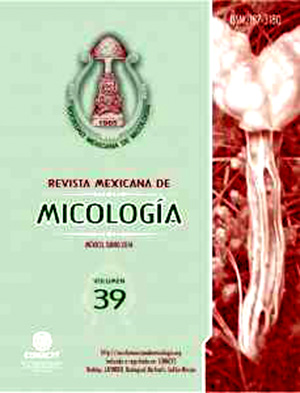The antigungal effect of Jacquinia macrocarpa plant extract on the growth of Aspergillus flavus, A. parasiticus and Fusarium verticillioides
DOI:
https://doi.org/10.33885/sf.2014.3.1120Keywords:
antifungal activity, maize pathogens, plant extractsAbstract
The aim of this study was to evaluate the effect of fractions obtained from the plant
}ac:quinia maaocarpa. against phytopathogenic fungi AspefBillus tlavus, A. parasiticus and
Fusarium verticillioides. The powder of the dried plant materials was extracted with methanol
(70 % v/v) and partitioned with hexane, ethyl acetate, and n-butanol. The most active fraction
against the radial growth of the fungi was further fractionated by silica gel chromatography. The
fraction from}. maaocarpa partitioned in n-butanol (BF) showed the highest antifungal activity
against the three fungi. Sub-fraction F5.4 completely inhibited the growth of F. verticillioides,
whereas the radial growth of A t1avus and A parasiticus was inhibited 70 % and 64 %,
respectively. Spores germination of A parasiticus and F. verticillioides was inhibited 7.8% and
11.8 %, respectively. The lengths and diameters of hyphae of the three fungi were smaller than
those of controls. Spore diameters of the Aspergillus species were reduced, while spores of F.
vertidllioides were not affected. The spore viability of A. flaws, A parasiticus and F.
verticillioides was reduced 40.7 %, 44.8% and 46.3 %, respectively. Fraction F5.4 significantly
inhibited the developmentofthethree fungi, mainly F. verticillioides
Downloads
Downloads
How to Cite
Issue
Section
License
Copyright notice
Open access policy
The authors who publish in this journal accept the following conditions:
In accordance with copyright laws, Scientia Fungorum recognizes and respects the authors’ moral rights, as well as the ownership of property rights, which will be transferred to the journal for dissemination in open access. Scientia Fungorum does not charge for submission and processing of articles for publication.
All the texts published by Scientia Fungorum –with no exception– are distributed under a Creative Commons License Attribution-NonCommercial-ShareAlike 4.0 International (CC BY-NC-SA 4.0), which allows third parties to use the publication as long as the work’s authorship and its first publication in this journal are mentioned.
The authors can enter into independent and additional contractual agreements for the nonexclusive distribution of the version of the article published in Scientia Fungorum (for example include it into an institutional repository or publish it in a book) as long as it is clearly and explicitly indicated that the work was published for the first time in Scientia Fungorum.
For all the above, the authors shall send the form of Letter-transfer of Property Rights for the first publication duly filled in and signed by the author(s). This form must be sent as a complementary file.
This work is licensed under a Creative Commons Attribution-NonCommercial-ShareAlike 4.0 International license (CC-By-NC-SA 4.0).



